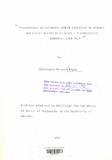| dc.description.abstract | This thesis attempts to explore the development of secondary
school education in two districts of Kenya, namely Mombasa
and Kilifi districts, in the post-independence era. Mombasa
is an urban centre, whereas Kilifi is a predominantly
rural district. The colonial government favoured development
of educational services .in urban centres, where the
majority of the non-African population lived. This is
evident from the fact that towards the close of the colonial
era nine government-aided secondary schools existed in Mombasa
whereas in the neighbouring district of Kilifi, only St.
George's High School provided education up to form four level.
After independence, the Government has pledged to accelerate
development in the rural areas of the country. Kenya's
National Development Plans emphasize. rural- development ,
This study is essentially divided in three parts, in line
with the three development plan periods from 1964 to 1978.
This thesis, therefore, discusses, the shift in emphasis
towards development of secondary school education in a rural
district vis-a-vis an urban centre during the three development
plan periods. In doing so, it tries to show the growth of
secondary schools in the two districts, qualifications of
teachers, various facilities provided in the schools,
examination results, etc.
This thesis further examines the economic, political,
cultural and social factors which affect the development of
secondary school education in Mombasa and Kilifi districts.
These factors, as is revealed in the the~is, have a strong
relevance to the growth of education. For instance, the
economic factor determines the ability of the parents to
pay school fees, to contribute towards harambee school
projects, to provide facilities for useful study at home,
etc. The cultural background of the people has a bearing
on the willingness of the parents, or otherwise, to send
their daughters to school.
The growth of primary education has an effect on the development
of secondary school education. This thesis, therefore,
discusses the development of primary education in two
districts during the three development plan periods, and
tries to show· what bearing it has on the development of
secondary school education. It also attempts to examine in
some detail the development of secondary school education
in the two districts before independence to enable the
reader to assess the situation during the colonial era.
The thesis further gives a detailed geographical and
historical background of Kilifi and Mombasa districts.
- x -
In one of the chapters relevant literature is reviewed
at length; here an attempt is made to show how studies
undertaken by various scholars in Kenya and elsewhere
on rural versus urban education are related to my theme,
and how my thesis tries to fill in the gap in the context
of two districts in Kenya. Finally, this thesis based on
certain findings, makes recommendations with regard to
the development of secondary school education in a rural
area vis-a-vis an urban centre. | en |

